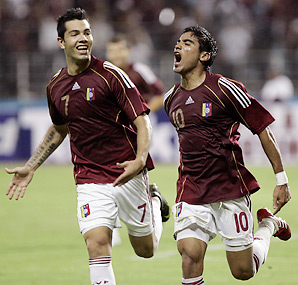|
|
|
Country Overview
►Introduction
■ Geographical
Statistics
■
People
■
Economy◄
Introduction
When asked about what Venezuela is known for, some may respond, "Political turmoil."
Others may say, "Simón Bolívar", "Oil production", or "Hugo Chávez."
Some people may base their answers from a travel perspective by replying, "Beautiful
Caribbean beaches", "Angel Falls," which is the world's highest waterfall, or "The Andes."
Venezuela is certainly a country of extremes - snow-covered Andes mountains, sweltering hot
Caribbean beaches, dense and rainy Amazon rainforests, political dictatorships,
sky-high inflation, and record-setting oil production.
Venezuela was first settled around 13,000 B.C. by the Yanomami Indians, whose descendants
still live in remote isolated pockets without direct contact with the outside world.
Venezuela is Spanish for "Little Venice." When the conquistadors sailed into Lake
Maracaibo in 1499, they saw local Indians living in rustic thatched houses on stilts above
the water. The Spaniards were, of course, making a sarcastic comparison with Venetian
opulence.
Venezuela boasts South America's superhero - Simón Bolívar. His bravery and foresight brought
independence to Venezuela, Colombia, Panama, Peru, Ecuador, and Bolivia. However, Venezuela
suffered the most from the wars for independence, during which 25% of the population died.
Venezuela was one of three countries that emerged from the collapse of Gran Colombia
in 1830 (the others being Ecuador and New Granada, which became Colombia). For most
of the first half of the 20th century, Venezuela was ruled by generally benevolent
military strongmen, who promoted the oil industry and allowed for some social
reforms. Democratically elected governments have held sway since 1959. Hugo Chávez,
president since 1999, seeks to implement his "21st Century Socialism," which
purports to alleviate social ills while at the same time attacking capitalist
globalization and existing democratic institutions. Current concerns include:
a weakening of democratic institutions, political polarization, a politicized
military, drug-related violence along the Colombian border, increasing internal
drug consumption, overdependence on the petroleum industry with its price
fluctuations, and irresponsible mining operations that are endangering the rain
forest and indigenous peoples.
back to top
Geographical Statistics
| Area: |
912,050 sq km (566,722 sq mi) |
| Coastline: |
2,800 km |
| Climate |
Tropical; hot, humid; more moderate in highlands |
| Terrain: |
Andes Mountains and Maracaibo Lowlands in northwest;
central plains (llanos); Guiana Highlands in southeast |
Lowest point: |
0 m at the Caribbean coastline |
| Highest Point: |
5007 m at Pico Bolivar (La Columna) |
| Natural Resources: |
Petroleum, Natural Gas, Iron Ore, Gold, Bauxite, Other minerals,
Hydropower, Diamonds |
| Natural Hazards: |
Subject to floods, rockslides, mudslides; periodic
droughts |
| Environmental Current Issues: |
Sewage pollution of Lago de Valencia; Oil and urban
pollution of Lago de Maracaibo; Deforestation; Soil degradation;
Urban and industrial pollution, especially along the Caribbean coast;
Threat to the rainforest ecosystem from irresponsible mining operation.
|
back to top
People
| Population: |
27,223,228 (July 2010 est.) |
| Age Structure: |
0 - 14 Years: 30%
15 - 64 Years: 64.7%
65 Years and Over: 5.3%
Median Age: 25.8 years
(2010 est.) |
| Population Growth Rate: |
1.515% |
| Birth Rate: |
20.29 births per 1000 population |
| Death Rate: |
5.14 deaths per 1000 population |
| Urbanization: |
Urban Population: 93%
Rate of Urbanization: 2% annually |
| Sex Ratio: |
0.98 Males per Female |
| Life Expectancy: |
Male: 70.69 Years
Female: 77 Years
Total Population: 73.77 Years |
| Major Infectious Diseases: |
Bacterial diarrhea; Dengue Fever; Malaria
Degree of Risk: High |
| Ethnic Groups |
Spanish, Italian, Portuguese, Arab, German, African,
Indigenous people |
| Religions: |
Roman Catholic: 96%
Protestant: 2%
Other: 2% |
| Languages: |
Spanish (Official)
Numerous indigenous dialects |
| Literacy |
93% |
| School Life Expectancy: |
12 Years |
back to top
Economy
| GDP Purchasing Power Parity: |
$350.1 billion USD (2009 est.) |
| GDP Official Exchange Rate: |
$357.6 billion USD (2009 est.) |
| GDP Per Capita (PPP): |
$13,100 USD (2009 est.) |
| GDP Composition by Sector: |
Agriculture: 4%
Industry: 36.8%
Services: 59.2% |
| Agriculture Products: |
corn, sorghum, sugarcane, rice, bananas,
vegetables, coffee, beef, pork, milk, eggs,
fish |
| Industries: |
petroleum, construction materials, food processing,
textiles; iron ore mining, steel, aluminum; motor
vehicle assembly |
| Labor Force: |
12.93 million |
| Unemployment Rate: |
7.9% (2009 est.) |
| Population Below Poverty Line: |
37.9% (2005 est.) |
| Revenues: |
$66.37 billion USD |
| Expenditures: |
$86.47 billion USD (2009 est.) |
| Public Debt: |
18% of GDP (2009 est.) |
| Inflation Rate of Consumer Prices: |
27.1% (2009 est.) |
| Central Bank Discount Rate: |
33.5% (2008) |
| Oil Production: |
2.472 million bbl/day (2009 est.) |
| Oil Exports: |
2.182 million bbl/day (2007 est.) |
| Oil Proven Reserves: |
99.38 billion bbl (2009 est.) |
| Natural Gas Production: |
23.06 billion cu m (2009 est.) |
| Natural Gas Proven Reserves: |
4.84 trillion cu m (2009 est.) |
| Exports - Commodities: |
Petroleum, Bauxite, Aluminum, Steel, Chemicals,
Agricultural Products, Basic Manufactures |
| Imports - Commodities: |
Raw Materials, Machinery Equipment, Transport Equipment,
Construction Materials |
| External Debt: |
$43.41 billion (2009 est.) |
| Exchange Rates: |
Bolivars (VEB) per US Dollar: 2.145 (2009)
In January 2010, Venezuela introduced a dual exchange
rate system for the fixed rate bolivar with 2.6 VEB
per USD on essentials, and 4.3 VEB per USD on all other
products. |
back to top
References -
click here
back to top
|
|
 |


